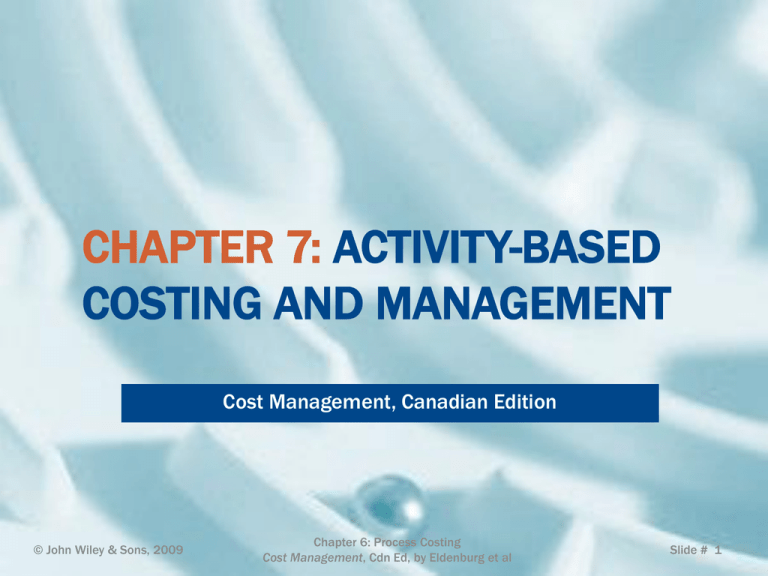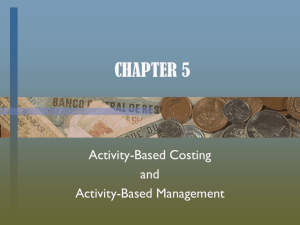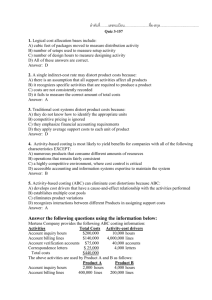
CHAPTER 7: ACTIVITY-BASED
COSTING AND MANAGEMENT
Cost Management, Canadian Edition
© John Wiley & Sons, 2009
Chapter 6: Process Costing
Cost Management, Cdn Ed, by Eldenburg et al
Slide # 1
Learning Objectives
• Q1: How is ABC different from traditional costing?
• Q2: What are activities and how are they identified?
• Q3: What process is used to assign costs in an ABC
system?
• Q4: How are cost drivers selected for activities?
• Q5: What is ABM?
• Q6: What are the benefits, costs, and limitations of
ABC and ABM?
© John Wiley & Sons, 2009
Chapter 7: Activity-Based Costing and Management
Cost Management, Cdn Ed, by Eldenburg et al
Slide # 2
Q1: How is ABC different from
traditional costing?
© John Wiley & Sons, 2009
Chapter 7: Activity-Based Costing and Management
Cost Management, Cdn Ed, by Eldenburg et al
Slide 3
Product Cost Cross Subsidization
• Inappropriate pooling of indirect costs and poor
choices for cost drivers can lead to the incorrect
costs of products or services.
• If one product is under-costed, then other
products may be over-costed resulting in product
cost cross subsidization.
• Sharing the bill at a restaurant is a good example!
© John Wiley & Sons, 2009
Chapter 7: Activity-Based Costing and Management
Cost Management, Cdn Ed, by Eldenburg et al
Slide # 4
Product Cost Cross Subsidization
• Suppose four people go out to dinner.
– two people are on diets and eat lightly
– two people order appetizers, large meals, & dessert
• If they share the bill equally, then all costs were
considered indirect and the cost allocation
base was number of diners.
• The dieters are subsidizing the other two diners.
© John Wiley & Sons, 2009
Chapter 7: Activity-Based Costing and Management
Cost Management, Cdn Ed, by Eldenburg et al
Slide # 5
Cost System Refinement
• An existing cost system can be improved by
– increasing the number of costs tracked as direct
– increasing the number of indirect cost pools
– using a better cause-and-effect cost allocation
base for each indirect cost pool
© John Wiley & Sons, 2009
Chapter 7: Activity-Based Costing and Management
Cost Management, Cdn Ed, by Eldenburg et al
Slide # 6
Product Cost Cross Subsidization Example
A company makes 2 products, Premium and Regular, with direct costs of
$120 and $80, respectively. Each product requires 5 DL hours, and the
overhead rate is $10/DL hour. However, the Premium product line is more
difficult to produce and manage. It takes twice the number of engineering
hours, four times the number of machine setups, and twice the hours in the
machining department to get a full run of Premium out the door. Determine
the traditional cost of each product and discuss.
Direct costs (DM+DL)
Overhead (5 hrs @ $10)
Premium
$120
50
$170
Regular
$80
50
$130
The use of a single indirect cost pool with direct labour hours
as an allocation base does not appropriately reflect the
consumption of resources during production.
© John Wiley & Sons, 2009
Chapter 7: Activity-Based Costing and Management
Cost Management, Cdn Ed, by Eldenburg et al
Slide # 7
Activity-Based Costing (ABC)
• ABC is a method of cost system refinement.
• Indirect costs are divided into “sub-pools” of costs
of activities.
• Activity costs are then allocated to the final cost
objects using a cost allocation base (more
commonly called cost drivers in ABC).
• Activities are measurable, making it more likely
that cost drivers can be found so that a final cost
object will absorb indirect costs in proportion to its
use of the activity.
© John Wiley & Sons, 2009
Chapter 7: Activity-Based Costing and Management
Cost Management, Cdn Ed, by Eldenburg et al
Slide # 8
Traditional Costing vs. ABC
Traditional costing systems:
Indirect
Costs
Indirect costs are
grouped into one (or a
small number) of cost
pools; a cost allocation
base assigns costs to
the individual products
© John Wiley & Sons, 2009
Product A
Direct Costs
Product B
Direct Costs
Product C
Direct Costs
The individual
products are the
final cost
objects.
Direct costs are
traced to the
individual
products.
Chapter 7: Activity-Based Costing and Management
Cost Management, Cdn Ed, by Eldenburg et al
Slide # 9
Traditional Costing vs. ABC
Activity-based costing systems:
Activity 1
Indirect
Costs
Activity 2
Activity 3
Indirect costs are
assigned (traced &
allocated) to various
pools of activity costs.
© John Wiley & Sons, 2009
Activity costs are
allocated to
products
Product A
Direct Costs
Product B
Direct Costs
Product C
Direct Costs
The individual products
are the final cost objects
& direct costs are traced
to the individual products.
Chapter 7: Activity-Based Costing and Management
Cost Management, Cdn Ed, by Eldenburg et al
Slide # 10
ABC in Manufacturing Example
Alphabet Co. makes products A & B. Product A is a low-volume specialty
item and B is a high-volume item. Estimated factory- wide overhead is
$800,000, and the number of DL hours for the year is estimated to be
50,000 hours. DL costs are $10/hour. Each product uses 2 DL hours.
Compute the traditional cost of each product if Products A & B use $25
and $10 in direct materials, respectively.
First, compute the estimated overhead rate:
Estimated overhead rate = $800,000/50,000 hours = $16/hour.
Direct materials
Direct labour (2 hrs @ $10)
Overhead (2 hrs @ $16)
© John Wiley & Sons, 2009
Product A
$25
20
32
$77
Chapter 7: Activity-Based Costing and Management
Cost Management, Cdn Ed, by Eldenburg et al
Product B
$10
20
32
$62
Slide # 11
ABC in Manufacturing Example
Alphabet Co. is implementing an ABC system. It estimated the costs and
activity levels for the upcoming year shown below.
Estimated Estimated Activity Levels
Costs
Prod. A Prod. B
Total Cost Driver
Machine set-ups
$200,000 3,000 2,000 5,000 # set-ups
Inspections
140,000
500
300
800 # inspections
Materials handling
80,000
400
400
800 # mat'l requistions
Machining dep't
320,000 12,000 28,000 40,000 # machine hours
Quality control dep't
60,000
600
150
750 # tests
$800,000
First, compute the estimated overhead rate for each activity:
© John Wiley & Sons, 2009
Chapter 7: Activity-Based Costing and Management
Cost Management, Cdn Ed, by Eldenburg et al
Slide # 12
ABC in Manufacturing Example
Estimated
Costs
Estimated Activity
Overhead Rate
$40
Machine set-ups
$200,000 5,000 set-ups
$40 /setup
/setup
$175
Inspections
140,000
800 inspections
$175 /inspection
/inspection
Materials handling
80,000
800 mat'l requistions $100
$100 /requisition
/requisition
$8
hr
Machining dep't
320,000 40,000 machine hours
$8 /mach
/mach hr
$80
Quality control dep't
60,000
750 tests
$80 /test
/test
$800,000
© John Wiley & Sons, 2009
Chapter 7: Activity-Based Costing and Management
Cost Management, Cdn Ed, by Eldenburg et al
Slide # 13
ABC in Manufacturing Example
Alphabet recently completed a batch of 100 As and a batch of 100 Bs. Direct
material and labour costs were as budgeted. Information about each batch’s
use of the cost drivers is given below. Compute the overhead allocated to
each unit of A and B.
100 As 100 Bs
Machine set-ups
60
10
Inspections
10
2
Materials handling
4
2
Machining dep't
240
120
Quality control dep't
3
1
Overhead allocated: 100 As 100 Bs
Machine set-ups
$2,400 $400
Inspections
1,750
350
Materials handling
400
200
Machining dep't
1,920
960
Quality control dep't
240
80
Overhead for batch $6,710 $1,990
Overhead per unit
© John Wiley & Sons, 2009
Chapter 7: Activity-Based Costing and Management
Cost Management, Cdn Ed, by Eldenburg et al
$67.10 $19.90
Slide # 14
ABC in Manufacturing Example
Compute the total cost of each product and compare it to the costs computed
under traditional costing.
Prod A Prod B
Direct material $25.00 $10.00
Direct labor
20.00 20.00
Overhead
67.10 19.90
$112.10 $49.90
Total
Traditional costing
assigned $77 to a unit of
Product A and $62 to a
unit of Product B.
• The only difference between the two costing systems is
that Product A is assigned more overhead costs under ABC.
• The additional overhead assigned to Product A reflects
Product A’s consumption of resources.
© John Wiley & Sons, 2009
Chapter 7: Activity-Based Costing and Management
Cost Management, Cdn Ed, by Eldenburg et al
Slide # 15
Q2: What are activities and
how are they identified?
© John Wiley & Sons, 2009
Chapter 7: Activity-Based Costing and Management
Cost Management, Cdn Ed, by Eldenburg et al
Slide 16
What are Activities and How are
They Identified?
• The ABC cost hierarchy includes the following
activities:
– organization-sustaining
– facility-sustaining
– customer-sustaining
– product sustaining
– batch-level
– unit-level
© John Wiley & Sons, 2009
Chapter 7: Activity-Based Costing and Management
Cost Management, Cdn Ed, by Eldenburg et al
Slide # 17
ABC Cost Hierarchy Example
Some of the costs incurred by the Dewey Chargem law firm are listed below.
This firm specializes in immigration issues and family law. For each cost,
identify whether the cost most likely relates to a(n) (1) organiz-ationsustaining, (2) facility-sustaining, (3) customer-sustaining, (4) productsustaining, (5) batch-level, or (6) unit-level activity and explain your choice.
Cost
Cost Hierarchy Level
Bookkeeping software
Salary for partner in charge of family law
Office supplies
Subscription to family law update journal
Telephone charges for local calls
Long distance telephone charges
Window washing service
Salary of receptionist
© John Wiley & Sons, 2009
Chapter 7: Activity-Based Costing and Management
Cost Management, Cdn Ed, by Eldenburg et al
Slide # 18
Q3: What process is used to
assign costs in an ABC system?
© John Wiley & Sons, 2009
Chapter 7: Activity-Based Costing and Management
Cost Management, Cdn Ed, by Eldenburg et al
Slide 19
What Process is Used to Assign
Costs in an ABC system?
• Identify the relevant cost object.
• Identify activities, and group homogeneous
activities.
• Assign costs to the activity cost pools.
• Choose a cost driver for each activity cost pool.
• Calculate an allocation rate for each activity cost
pool.
• Allocate activity costs to the final cost object.
© John Wiley & Sons, 2009
Chapter 7: Activity-Based Costing and Management
Cost Management, Cdn Ed, by Eldenburg et al
Slide # 20
Q4: How are cost drivers
selected for activities?
© John Wiley & Sons, 2009
Chapter 7: Activity-Based Costing and Management
Cost Management, Cdn Ed, by Eldenburg et al
Slide 21
How Are Cost Drivers Selected for
Activities?
• For each activity, determine its place in the ABC
cost hierarchy.
• Look for drivers that have a good cause-and-effect
relationship with the activities’ costs.
• Use a reasonable driver when there is no causeand-effect relationship.
© John Wiley & Sons, 2009
Chapter 7: Activity-Based Costing and Management
Cost Management, Cdn Ed, by Eldenburg et al
Slide # 22
Q5: What is ABM?
© John Wiley & Sons, 2009
Chapter 7: Activity-Based Costing and Management
Cost Management, Cdn Ed, by Eldenburg et al
Slide 23
Activity-Based Management (ABM)
• ABM is the process of using ABC information to
evaluate opportunities for improvements in an
organization.
• Examples include managing & monitoring
– customer profitability
– product and process design
– environmental costs
– quality
– constrained resources
© John Wiley & Sons, 2009
Chapter 7: Activity-Based Costing and Management
Cost Management, Cdn Ed, by Eldenburg et al
Slide # 24
ABM & Customer Profitability
• Activities can be defined so that different costs of
servicing customers are accumulated.
• Examples include
– analyzing the types of bank transactions used by
various categories of customers
– comparing the costs of servicing insurance contracts
sold to married versus single individuals
– comparing the costs of different distribution channels
© John Wiley & Sons, 2009
Chapter 7: Activity-Based Costing and Management
Cost Management, Cdn Ed, by Eldenburg et al
Slide # 25
ABM & Product/Process
Improvements
• Activities can be defined so that the costs of stages
of production or of a business process are
accumulated.
• Examples include
– determining the costs of non-value-added activities so
the most costly can be reduced or eliminated
– changing the steps in the accounts payable function
to reduce the number of personnel
– determining the most costly stages of product
development so that the time to market is reduced
© John Wiley & Sons, 2009
Chapter 7: Activity-Based Costing and Management
Cost Management, Cdn Ed, by Eldenburg et al
Slide # 26
ABM & Environmental Costs
• Activities can be defined so that types of
environmental costs are accumulated.
• Examples include
– capturing the costs of contingent liabilities for waste
disposal site remediation
– comparing the cost of recycling packaging to the cost
of disposal
– computing the costs of treating different kinds of
emissions
© John Wiley & Sons, 2009
Chapter 7: Activity-Based Costing and Management
Cost Management, Cdn Ed, by Eldenburg et al
Slide # 27
ABM & Quality Costs
• Activities can be defined so that categories of costs
of managing quality are accumulated.
• Common categories of quality costs are
– costs of prevention activities
– costs of appraisal activities
– costs of production activities
– costs of postsales activities
© John Wiley & Sons, 2005
Chapter 7: Activity-Based Costing and Management
Cost Management, Cdn Ed, by Eldenburg et al
Slide # 28
Q6: What are the benefits,
costs, and limitations of ABC
and ABM?
© John Wiley & Sons, 2009
Chapter 7: Activity-Based Costing and Management
Cost Management, Cdn Ed, by Eldenburg et al
Slide 29
Benefits & Costs of ABC and ABM
• Benefits
– more accurate product cost information
– employees focus attention on activities
– measurement of the costs of activities and business
processes
• Costs
– ABC systems are difficult to design and maintain
– more information must be captured
– decision makers may not use the information
appropriately
© John Wiley & Sons, 2009
Chapter 7: Activity-Based Costing and Management
Cost Management, Cdn Ed, by Eldenburg et al
Slide # 30
Uncertainties in ABC and ABM
Implementation
• Judgement is required when determining activities.
• Judgement is required when selecting cost drivers.
• Denominator levels for cost drivers are estimates.
• ABC information includes unitized fixed costs, so
decision makers must use ABC information correctly.
© John Wiley & Sons, 2009
Chapter 7: Activity-Based Costing and Management
Cost Management, Cdn Ed, by Eldenburg et al
Slide # 31
Copyright
Copyright © 2009 John Wiley & Sons Canada, Ltd. All rights reserved.
Reproduction or translation of this work beyond that permitted by
Access Copyright (The Canadian Copyright Licensing Agency) is
unlawful. Requests for further information should be addressed to the
Permissions Department, John Wiley & Sons Canada, Ltd. The
purchaser may make back-up copies for his or her own use only and not
for distribution or resale. The author and the publisher assume no
responsibility for errors, omissions, or damages caused by the use of
these programs or from the use of the information contained herein.
© John Wiley & Sons, 2009
Chapter 7: Activity-Based Costing and Management
Cost Management, Cdn Ed, by Eldenburg et al
Slide 32





